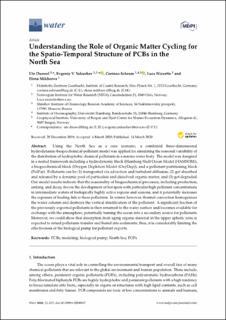| dc.description.abstract | Using the North Sea as a case scenario, a combined three-dimensional hydrodynamic-biogeochemical-pollutant model was applied for simulating the seasonal variability of the distribution of hydrophobic chemical pollutants in a marine water body. The model was designed in a nested framework including a hydrodynamic block (Hamburg Shelf Ocean Model (HAMSOM)), a biogeochemical block (Oxygen Depletion Model (OxyDep)), and a pollutant-partitioning block (PolPar). Pollutants can be (1) transported via advection and turbulent diffusion, (2) get absorbed and released by a dynamic pool of particulate and dissolved organic matter, and (3) get degraded. Our model results indicate that the seasonality of biogeochemical processes, including production, sinking, and decay, favors the development of hot spots with particular high pollutant concentrations in intermediate waters of biologically highly active regions and seasons, and it potentially increases the exposure of feeding fish to these pollutants. In winter, however, thermal convection homogenizes the water column and destroys the vertical stratification of the pollutant. A significant fraction of the previously exported pollutants is then returned to the water surface and becomes available for exchange with the atmosphere, potentially turning the ocean into a secondary source for pollutants. Moreover, we could show that desorption from aging organic material in the upper aphotic zone is expected to retard pollutants transfer and burial into sediments; thus, it is considerably limiting the effectiveness of the biological pump for pollutant exports. | en_US |

